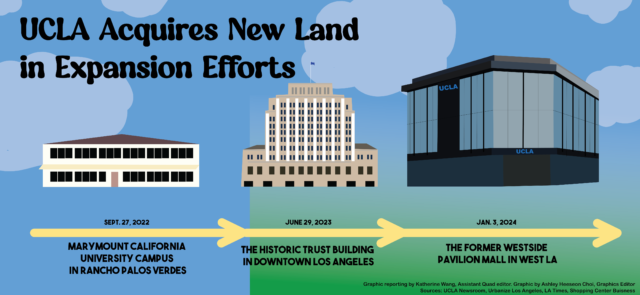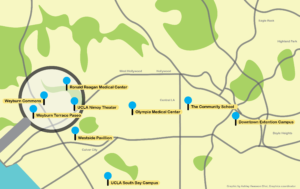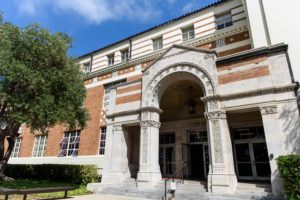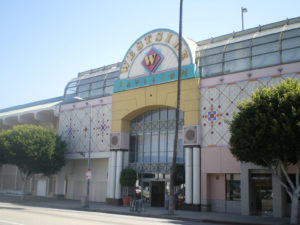UCLA has acquired three properties in the past two years, enabling various opportunities for the university throughout Los Angeles.
These three properties include the former Marymount California University campus in Rancho Palos Verdes, Trust Building in downtown Los Angeles and Westside Pavilion mall in West LA. In making these purchases, the university considered alignment with UCLA’s strategic goals, unique features of the properties and the potential academic opportunities an acquisition could facilitate.
In September 2022, UCLA purchased the former Marymount University Campus in Rancho Palos Verdes with plans to use the land as UCLA’s South Bay campus to increase enrollment and for research purposes, according to the university.
In an emailed statement, Andrea Kasko and Christina Christie, co-chairs of the Joint Task Force on the Academic Mission of UCLA Campus Expansion, said the Palos Verdes purchase presented multiple research opportunities. For example, its location near the port of LA, an ecosystem with unique flora and fauna, makes it suitable for urban ocean-focused research, Kasko and Christie said in the statement.
“Its proximity to the port of Los Angeles connects the campus to the global economy, and labor practices and movements in related economies and could present research opportunities to UCLA faculty, staff and students studying global economies, labor studies, the blue and green economies and related areas,” Kasko and Christie said in the statement.
In June 2023, UCLA purchased the former Trust Building in downtown LA to engage the greater LA community beyond Westwood, according to UCLA Newsroom. Downtown LA has long been a place where academic institutions have sought to expand, according to CoStar News.
The University of Southern California, California State University LA, the Claremont Graduate University and even Arizona State University have all opened up satellite campuses in the downtown area, citing benefits such as the commercial hubs and high-profile offices in the area, which create opportunities for students.
Mark Tarczynski, executive vice president at Colliers International, a commercial real estate firm with offices in LA, said downtown LA has many aspects that make it appealing to educational institutions and other large businesses that are looking to expand.
“It’s all about the availability of all of the infrastructure,” Tarczynski said. “You’ve got retail, you’ve got police, fire, you’ve got massive amounts of electricity available. … All of that is much better than buying some farmland.”
But the process of making these purchases can take a significant amount of time and multiple players, according to those involved in the purchases.
Executive Vice Chancellor and Provost Darnell Hunt said the process of purchasing new properties begins with the real estate office, a department that reported to then-Interim Vice Chancellor and Chief Financial Officer Allison Baird-James at the time of the purchases.
“Her office plays a major role in negotiating the price and working out the financing,” Hunt said. “For the bigger projects like South Bay and the research park we had to get regental approval before we could move forward with the purchases.”
Hunt added the process of purchasing the South Bay property also included negotiations with the former Marymount California University and presenting a layout of what UCLA’s plan would look like for the now-shut-down university campus.
The process also involved consideration of how to finance the purchase, given the high cost of buying land in California.
The former college campus cost UCLA $80 million, according to the LA Times. The purchase was financed with general revenue bonds, a type of loan issued by the government. These loans are commonly used by institutions to finance large public projects and are paid back over time through income generated by the project.
UCLA’s most recent purchase was the former Westside Pavilion mall, made in January. This purchase was made for research reasons, with plans to use the space for UCLA’s technology and immunotherapy teams.
On top of detailed planning and financing, the Westside Pavilion mall purchase was made possible with the help of external parties.
According to UCLA Newsroom, technology company Google provided support to UCLA’s purchase of the mall. As the previous tenant of the space, Google helped redevelop the abandoned mall into an office space with real estate groups Hudson Pacific Properties and Macerich before selling the property to the university.
Despite the support real estate developers can provide, Tarczynski added that the purchasing and permitting process for LA in general can often be difficult.
“Los Angeles is what we call a high barrier to entry city,” Tarcyznski said. “And that’s because the planning and land use and permitting process is just so Byzantine.”
These three recent purchases all have varied plans for their uses, ranging from research and development to expanding enrollment. They were made with the explicit reason of advancing UCLA’s strategic goals, which include deepening UCLA’s engagement with LA and expanding the university’s research and creative activities, Hunt added.
UCLA South Bay will expand enrollment at the university, in alignment with UC-wide strategic goals to enroll more students and award significantly more degrees by 2030. South Bay will host various academic programs supplemented by its location, including a focus on sustainability and environmental justice. UCLA Extension will also begin to offer courses at UCLA South Bay this summer.
In alignment with goals of community engagement, UCLA Downtown has 31 programs set to start operations in the building. These programs include community outreach to youth and the nearby Skid Row neighborhood, as well as academic programs such as centers for the UCLA School of Law and UCLA Extension. The building will also house UCLA-affiliated research projects such as the Luskin Institute on Inequality and Democracy.
Hunt said the goal of UCLA Downtown is to be a collaborative space where larger topics can be studied by many departments to offer different perspectives. One of the requirements for programs looking to occupy space in the downtown building was to develop an interdisciplinary project, Hunt added.
“We see it as a catalyst that will create knowledge beyond what we’re able to do on campus because of … people being separated by discipline, by school, by department,” Hunt added.
The former Westside Pavilion will operate as UCLA Research Park and host the California Institute for Immunology and Immunotherapy and the UCLA Center for Quantum Science and Engineering. This research will be supported by funds from the state of California, various philanthropic donors, and private institutions and corporations, according to UCLA Newsroom.
None of these acquisitions are intended to replace UCLA’s operations in Westwood or to redirect any of the university’s activities to an alternate site of instruction, Hunt said.
“We’ve been very clear that UCLA is Westwood,” Hunt said. “These other acquisitions are complements to Westwood.”
Looking forward, Hunt added while the university is not currently eyeing any purchases, the school will be proactive about any opportunities, especially regarding expanding housing options.
“One of the areas where we’ll continue to have need is with housing,” Hunt said. “If opportunities present themselves to acquire properties that would provide housing for students and graduate students and faculty, that could be something we could see on the horizon.”





Comments are closed.